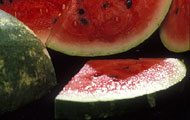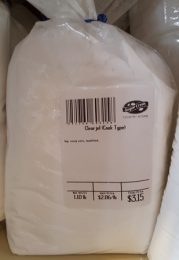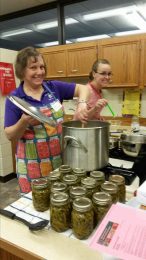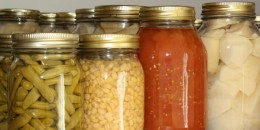There are several reasons. First, the beans may be too mature which makes them too starchy. The starch settles out of the food during canning. Second, minerals in hard water can give a cloudy appearance. Third, using table salt instead of canning salt. Table salt contains anti-caking agents that can cause cloudiness. With any of these three causes, it is a quality issue. Finally, it could be spoilage due to improper heat processing. Do not consume them in this case.
Tag: Canning
Can I add bacon to green beans before canning them?
This is an example of creating your own recipe can be a dangerous practice. While bacon and green beans are both low-acid foods, there are no processing recommendations for canning bacon. Therefore, can the beans by themselves. Then when ready to eat the beans, add the bacon just before serving.
Adding any fat or butter to home-canned products, unless specifically stated in the recipe may slow the rate of heat transfer during processing. This will result in an unsafe product. Additionally, the fat could seep in between the lid and jar rim and the lid will not seal properly.
Spices or herbs may be added in small amounts before processing.
Source: https://learningstore.uwex.edu/Assets/pdfs/B1159.pdf
New Recipe Cards from Ball®
 In an ongoing effort to make home food preservation easy and to appeal to those who can foods in small quantities, Ball® now has six new mixes for pickles and tomato products.
In an ongoing effort to make home food preservation easy and to appeal to those who can foods in small quantities, Ball® now has six new mixes for pickles and tomato products.
They are a recipe card with six seasonings attached to the card. On the back are instructions with additional ingredients to add and processing instructions. Each recipe card makes two quarts or four pints.
The recipe cards include three types of pickles, two types of salsa, and a pasta sauce.
Learn more at www.freshpreserving.com/mixes/.
Are All Fruits High in Acid?

When it comes to canning, foods are divided into two categories. Low acid foods have a pH 4.6 or above and high acid foods have a pH of 4.6 or below. In general, fruits fall into the high acid category. But, there are some exceptions.
Melons, including watermelon, honey dew and cantaloupe, are examples of low acid fruits. They have an average pH of 6.2. So, to can them, significant amounts of acid and sugar must be included to safely can them in a boiling water bath canner. In March of 2011, there was an outbreak of botulism linked to watermelon jelly sold in Canada.
So, it is important to choose recipes from trusted resources in all canning, and especially with low acid foods. A good recipe for Watermelon Jelly can be found in the Ball Complete Book of Home Preserving or at www.bernardin.ca/recipes/zesty-watermelon-jelly.htm?Lang=EN-US. Bernardin is the Canadian brand of Ball canning products.
Remember, while tomatoes are classified as a vegetable, they are botanically a fruit. Acid, either lemon juice, vinegar, or citric acid, must be added to tomatoes for safe canning. Details can be found at www.bookstore.ksre.ksu.edu/pubs/MF1185.PDF.
Canning Timer & Checklist App
There’s now an app for that! Oregon State University has created a free app for your mobile device for instructions on canning vegetables, fruits, meats and fish.
This app is intended for people with previous canning experience. It has reminders for essential steps in the canning process. It also includes altitude adjustments and a built-in timer for the product you are canning.
This free app is available for Apple and Android devices. Learn more at: https://catalog.extension.oregonstate.edu/pnw689.
Looking for Clear Jel?

When canning pie filling, recipes use Clear Jel as the thickener. It produces a thick, clear consistency and survives the heat treatment of canning.
But locating Clear Jel is a challenge. If you are in the St. Mary’s, KS area, stop by the Sugar Creek Country Store and pick up your supply of Clear Jel (Cook Type).
For this and other sources for Clear Jel, go to www.rrc.k-state.edu/preservation/canning.html.
Food Preservation Classes
 Food preservation classes are for anyone! If you are a new FCS Agent, a 4-H Foods leader or member, or just want to learn about food preservation, sign up! The current list of classes I have scheduled are as follows:
Food preservation classes are for anyone! If you are a new FCS Agent, a 4-H Foods leader or member, or just want to learn about food preservation, sign up! The current list of classes I have scheduled are as follows:
April 12—Olathe, KS, contact Crystal Futrell, 913-715-7000
May 1– Lincoln, KS, contact Ashley Svaty, 785-524-4432
May 23—Osawatomie, KS, contact Franny Eastwood, 913-795-2829
May 24—Lawrence, KS, contact Susan Johnson, 785-843-7058
June 28—Grantville, KS, contact Cindy Williams, 785-863-2212, or Susan Fangman, 785-232-0062
Can I Home Can Creamed Soup?

Soup is a tasty winter meal. But not all types of soup can be safely canned at home. Here’s some cautions for creamed soup.
- Creamed soups are best preserved by freezing for safety.
- Creamed soups are thickened with flour or other thickeners. These slow the heat transfer through the jar. This could lead to botulism. The safest choice is to add thickening agents when preparing the soup to eat.
- All dairy products are low acid foods and should never be canned. Add these to soups just before serving.
- Noodles, pasta, rice, dumplings, barley, etc. should not be canned. These foods interfere with heat transfer through the jar. Add these just before serving.
- Thickened or creamed tomato soup should not be canned. Instead, can tomato juice, tomato vegetable juice blend, or crushed tomatoes (without added vegetables). When ready to make the tomato soup, add seasoning, vegetables, and thickeners, as desired.
For more information, see http://nchfp.uga.edu/publications/nchfp/factsheets/soups.html.
Home Canning Soup
So what soups are safe to can you ask? Vegetable soups with or without meat or meat broth may be safely canned using the process time that takes the longest time as an individual ingredient. Most soups will take 60 to 90 minutes to process in a pressure canner depending upon size (pints or quarts) and ingredients. Never can soup in half-gallon containers. Use caution to avoid packing ingredients into the jars. For vegetable soup, fill the jars half full of solids, add broth allowing 1 inch headspace and process in a pressure canner. Space is needed for the hot liquid to circulate between the food particles. Pieces of cooked beef or chicken can be added to the vegetables to make a vegetable meat soup.
Source: http://nchfp.uga.edu/publications/nchfp/factsheets/soups.html
Is It Safe to Re-can Already Canned Food?
 People often think that they can save money by buying larger containers of canned food, transferring the contents (or leftovers from the first use) to smaller jars and re-processing it. Others wonder if this is a way to save leftovers from any size can for a longer time than they will keep in the refrigerator.
People often think that they can save money by buying larger containers of canned food, transferring the contents (or leftovers from the first use) to smaller jars and re-processing it. Others wonder if this is a way to save leftovers from any size can for a longer time than they will keep in the refrigerator.
There are three main problems with doing this:
- There are no safe tested process to do this. The way heat goes through a jar of already canned food is different than fresh food. The food will become very soft and compact more. This could lead to underprocessing and spoilage.
- There is no cost savings in re-canning foods.
- The food quality will be greatly reduced. Nutrients will be lost and more textural changes will occur.
Bottom line, do not plan to re-can any food.
Source: http://nchfp.uga.edu/questions/FAQ_canning.html#32
